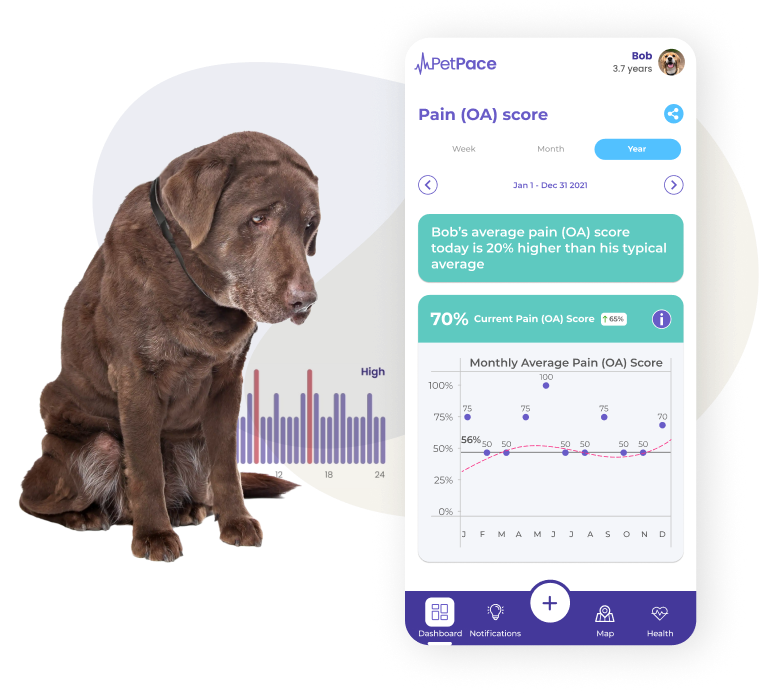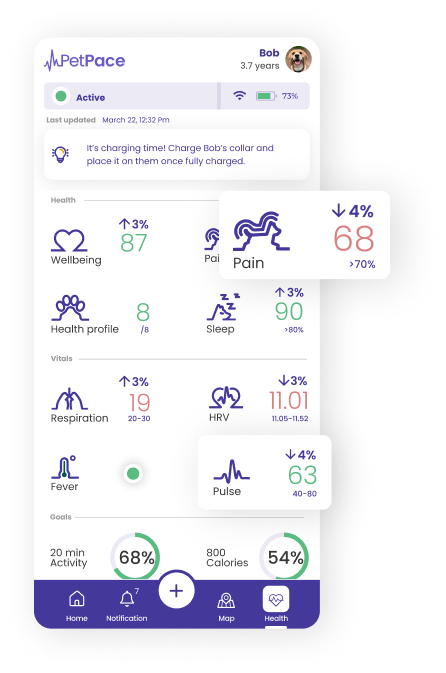PetPace and Arthritis in Dogs
PetPace developed the ability to identify arthritis (OA) in dogs through biometric monitoring.
A study conducted by leading US universities, which examined healthy dogs’ biometric data against dogs with OA, is the basis of this revolutionary capability to remotely assess pain and detect arthritis in dogs.
The collars collect a range of physiological and behavioral biometrics, such as pulse, HRV, activity, and posture data, for daily assessment of the likelihood that the dog is experiencing OA-related pain. Currently, to the best of our knowledge, there is no method or device other than PetPace that can reliably and objectively detect pain in pets in their natural environment, i.e., outside of a veterinary facility.


What Causes Arthritis in Dogs?
In this article, we look at the causes of arthritis in dogs and how to slow deterioration, so as to keep your dog active for longer.
How does the word ‘arthritis’ make you feel?
When linked to your dog, arthritis evokes all sorts of emotions. It might be a senior dog and you feel sad that decline is inevitable. Or a young dog is afflicted with premature arthritis due to hip dysplasia, which leaves you frustrated about what lies ahead.
Emotional as the topic of arthritis is, you shouldn’t feel things are hopeless. There are ways to take control, protect your dog’s joints, and therefore his quality of life.
What Exactly is Arthritis in Dogs?
Arthritis a term used so often you may assume a certain level of knowledge, but how much do you really know?
Stripping things back to facts, arthritis is an inflammatory, progressively degenerative disease affecting the joints (Arthro- meaning joints, and –itis meaning inflammation.)
Poor Cartilage
Arthritis in dogs is linked to a number of problems such as poor quality cartilage lining the joint surfaces. Cartilage is nature’s shock absorber. When the cartilage is thinner and less spongey, the joint as less cushioned, making movement painful.
Inflammation
It’s inflammation of the joint lining that causes the pain (think of inflamed eye or irritated skin, and how uncomfortable this is). Inflamed cells release ‘toxic’ chemicals, which cause further inflammation and hey presto, a classic vicious circle, of inflammation, is created.
Wear and Tear
Over time, inflammation results in erosion (wearing away) of the joint surface. To repair the damage the body lays down new bone, which remodels the joint. The ultimate result is a swollen, thickened joint that no longer fit snugly together.
What Causes Arthritis in Dogs?
Maybe you have a 16-year old Jack Russell that still skips around like a puppy. Or maybe you have a three-year-old Labrador who already needs a hip replacement. Why the difference: Why is it some dogs escape arthritis whilst other suffer at an early age?
This is because arthritis in dogs is ‘multifactorial’, which in plain terms means it is a combination several reasons. Here are the most important reasons:
Hereditary Factors
Many breeds carry genetic coding passed from parent to pup, which predetermines that their joints are badly shaped. When a joint rubs or catches when the dog moves which sets up inflammation and joint remodeling.
Damage or Trauma
This is a big worry for pups, as their joints are slack to allow room for growth. This makes joints vulnerable to physical damage when a puppy moves awkwardly or jumps from a height. A pup that lands heavily and chips the cartilage lining of a joint, sows the seeds of early arthritis.
Poor diet
This isn’t just about a diet lacking in nutrients (although obviously, this is important) but also about diets that are too rich, and force bones to grow too fast, making them vulnerable to damage. The classic example is a giant breed fed on a puppy food designed for small dogs.
Infection
Although rare, blood-borne infections can seed the joints and set up infective arthritis
Auto-immune Disease
The immune system attacks the joints, causing inflammation
Signs of Arthritis in Dogs
The dog arthritis symptoms aren’t hard to spot. They range from a dog that’s stiff and slow in the mornings to the dog who struggles to stand, and all the stages of lameness in between.
However, it’s important that a veterinarian examines the dog because lameness is a general symptom rather than a diagnosis of arthritis in its own right. The veterinarian needs to check for other causes of lameness including neurological problems, foreign bodies, and strains and sprains.
Reducing the Risk of Arthritis
What you really want to know is how to keep your dog’s joints healthy for longer. So here goes….
Pre-Purchase Checks
It should be said that when purchasing a purebred pup, be sure to do your homework. Check what health problems the breed is linked to. If one of the issues is hip or elbow dysplasia, then investigate what screening programs are in place.
Then quiz the breeder about what tests the parent dogs have had to rule out passing down hip or elbow problems. If the breeder doesn’t screen her dogs then walk away and keep looking.
Ideally, only buy from a breeder who screens both parents and they have good scores. This reduces (but unfortunately not eliminates) the risk of the pups developing dysplasia.
Joint Care for Growing Dogs
Look after a puppy’s growing joints, as this is a time when they’re particularly vulnerable to damage. As a rule of thumb, never exercise a puppy to the point of exhaustion. This is because the ligaments and tendons that support the joints are lax to allow for growth. But when the muscles get tired this allows for bone-on-bone movement and cause damage.
Be careful about what you feed the puppy. It’s vital to have an appropriate balance of calcium and phosphate for healthy bone growth. This requirement differs between small dogs (who grow rapidly) and larger dogs (who grow more slowly).
Thus, large or giant breed dogs require to be fed a different formula of puppy food to small or toy dogs. To ignore this means stimulating the bones to grow too quickly, which outstrips the blood supply to the cartilage lining the joints, and causes poor joint development.
Another important factor is the amount of food fed. Be sure to keep the puppy lean as this promotes a good waistline in adult life (obesity being a major contributing factor to arthritis).
Joint Care for Adult Dogs
Keep your dog trim for all-round good health, especially of joints. Also, regular exercise is crucial to keeping joints supple and moving. However, keep the amount of exercise similar from day to day. Sudden heavy exercise will tire the dog, which may then move clumsily and chip a joint lining causing inflammation…
Another suggestion is to give a daily food supplement containing chondroitin and glucosamine. These help nourish the joints and prepare the raw materials for cartilage repair and thick, lubricating joint fluid. Think of these as an investment in the long-term health of the dog’s joints. If your dog is a breed prone to joint dysplasia or arthritis, then this is certainly something to consider.
What to Do if Your Dog has Arthritis
For those with dogs that already have arthritis, there are still things you can do to help.
Early-stage Arthritis
-
Chondroprotectants
Glucosamine and chondroitin come under the heading of supplements that promote good joint health. Omega 3 fatty acids also reduce inflammation. There’s also an injection your dog can have that increase lubrication within the joints and promote smooth articulation. -
Weight Management
If your dog is on the heavy side, put him on a diet. It reduces the load-bearing weight on the joints and slows up deterioration. -
Regular Exercise
Keep the dog moving, with regular exercise that is within his capabilities. This tones the muscles which in turn support the joints. Check with your veterinarian as to what is a safe level for your dog.
Advanced Arthritis
-
Medications
Canine prescription anti-inflammatory medications do just that – relieve inflammation. This reduces pain and can also reduce the inflammation which makes the joints vulnerable to further damage. -
Heat Therapy
Don’t overlook keeping the dog warm at night and also placing warm wheat bags on a sore joint to increase blood flow and ease discomfort. -
Warm-up before Exercise
Just like an athlete warms up before a race, so an arthritic dog should warm up his joints before walking. Speak to your veterinarian about learning passive flexion and extension exercises. -
Non-weight Bearing Exercise
Try to keep the dog moving. When joints are sore then weightless exercise such as hydrotherapy (swimming under controlled conditions) is excellent for both mind and body. -
Physiotherapy
A veterinary physiotherapist can give you invaluable exercise and therapeutic options that don’t include drugs. The benefits of massage for dogs with arthritis are often overlooked. Then there are other therapies such as laser, acupuncture and TENS, which can make your pet pal more comfortable.
Exercise for Arthritic Dogs
Always follow your veterinarian’s advice, but as a general rule appropriate, gentle exercise is good for dogs with arthritis. This helps to tone the muscle which supports the joints, maintains cardiovascular fitness, and is good for the dog’s weight and mental health.
However, it’s important to avoid the ‘weekend warrior’ syndrome, where the dog has little exercise during the week and goes for long weekend walks. This places heavy demands on muscles and joints that aren’t toned up enough to deal with the stress. In turn, this means the dog is more likely to move awkwardly and cause further damage to the joints.
This is where a PetPace collar can prove invaluable. It enables you to track the dog’s daily exercise so as to plan a steady schedule that conditions and strengthens the muscles supporting those sore joints.
Small Steps Add up to Big Benefits
And finally, don’t lose hope because a single strategy failed to make a noticeable difference.
When wondering what to do if your dog has arthritis, the trick is knowing that lots of little things can add up to a big difference. For example, a nutraceutical alone may not make the dog more comfortable, but when you add in massage, gentle exercise, pain-relievers, and heat therapy at night, your dog will turn the corner in more ways than one!
